Menu
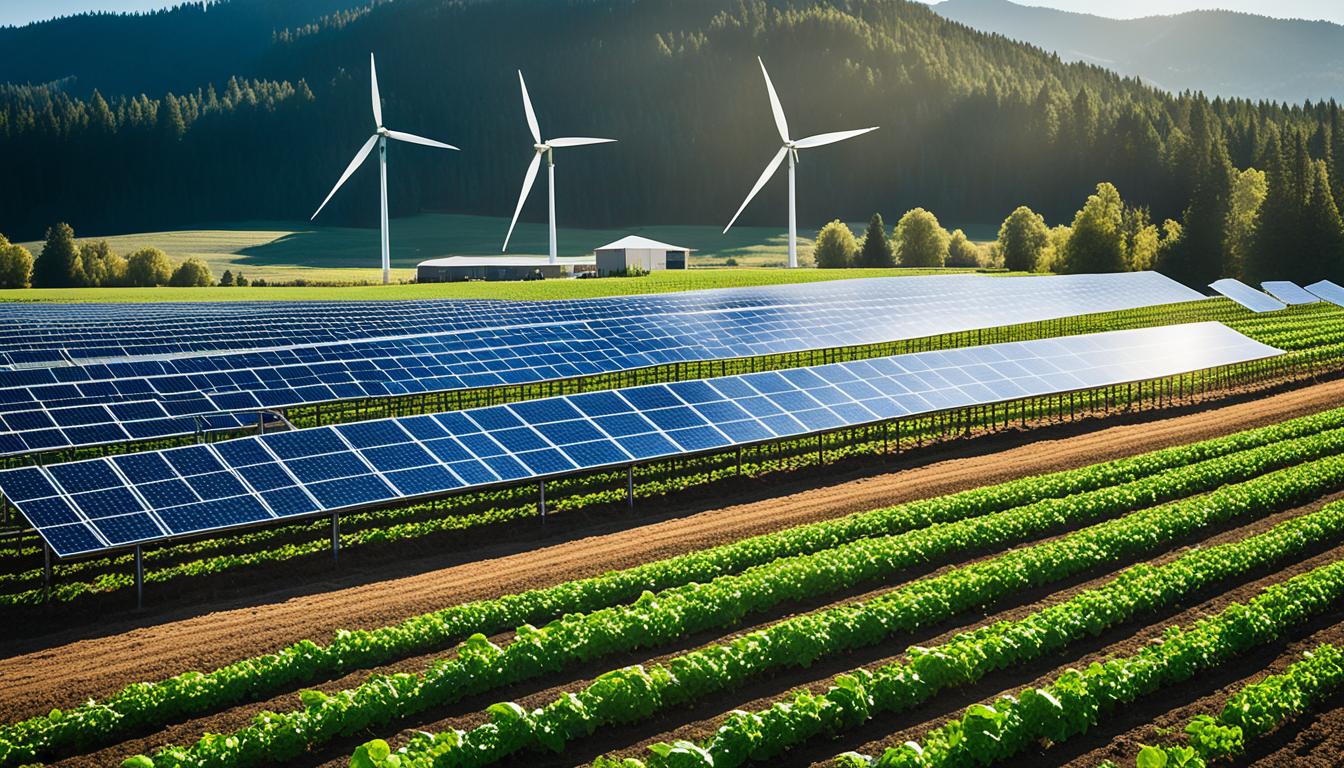
“The ultimate test of a moral society is the kind of world that it leaves to its children.” – Dietrich Bonhoeffer
Climate-smart agriculture (CSA) is a key way for farmers to deal with climate change’s effects. It helps them be more sustainable and strong against climate issues. The USDA plans to invest $1.5 billion in climate-friendly farming for the next five years through the Regional Conservation Partnership Program (RCPP). This will help over 180,000 farms and more than 225 million acres.
This plan includes ways to cut down on harmful gases and increase ways to store carbon in the soil. It also aims to improve how water and nutrients move through the land. By doing this, farmers can face climate challenges better.
The global agrifood system is a big part of the world’s emissions. Farming leads to a lot of deforestation too. Climate-smart agriculture (CSA) is a big idea to help. It aims to make farming better without hurting the planet. This approach focuses on being productive, strong, and green under any weather conditions.
Climate-smart agriculture is about using smart ways to farm. It boosts how much food we can grow and how tough farms are against bad weather. It mixes old and new ideas in farming. For example, it uses ways to till the land that keep the soil healthy. It also manages plant food in a clever way. This helps farmers deal with different weather patterns.
CSA aims to make more food, make farms better at handling bad weather, and help fight climate change. The World Bank puts a lot of money into these efforts. CSA brings good things to farming, the environment, and people. It supports growing crops that can survive different climates. This way, our farms can still give us food, no matter how the weather changes.
| Statistic | Details |
|---|---|
| Global Emissions from Agrifood Systems | One-third of all emissions |
| Projected Global Food Demand by 2050 | Increase to feed 9.7 billion people |
| World Bank CSA Financing | Nearly $3 billion annually |
Farming gets only a small part of money set aside for fighting climate change. Yet, it’s key to saving places like the Amazon. More money and better plans mean we can grow food in ways that don’t harm the earth. This is important for keeping food coming and keeping the planet healthy.
Climate-smart agriculture aids in transforming food systems into solutions for climate change, reinforcing the need for adaptive farming techniques and comprehensive support.
As the world needs more food for nearly 10 billion people by 2050, CSA becomes more crucial. By using special crops and clever ways to manage farms, growers can keep food coming. They also help stop climate change by farming in smart, green ways.
Soil health is vital for climate-smart farming to thrive. With the right soil care, farms can lower their carbon footprint. They do this by focusing on keeping the soil undisturbed and well covered.
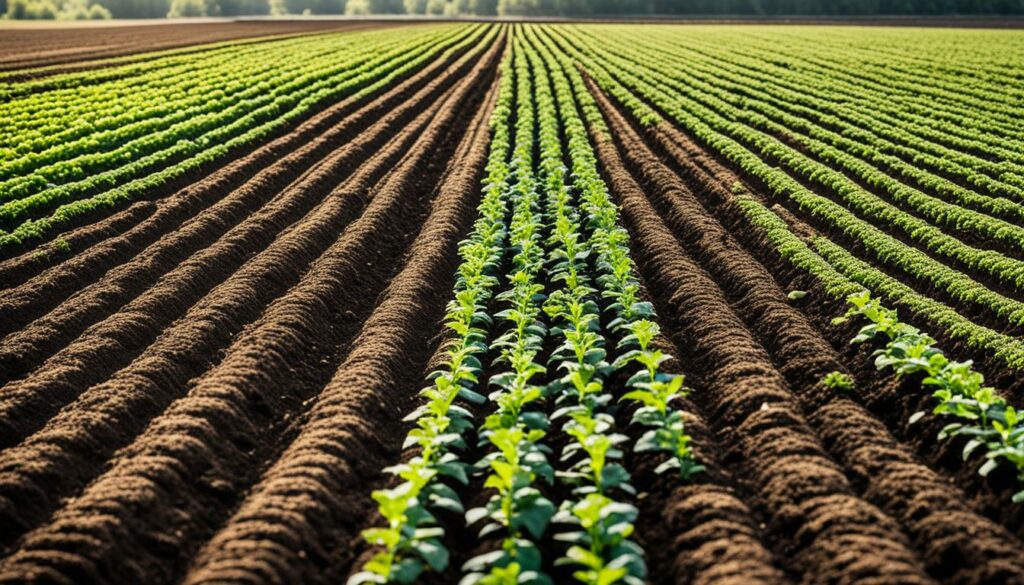
Keeping the soil as it is helps it stay healthy. No-till farming and reduced tillage are key. They protect the soil and lock carbon in, reducing harmful emissions.
The American Farmland Trust shows that no-till methods boost carbon in the soil. Tools like EarthOptics’ TillMapper™ help make the right no-till plans. This means farmers can look after their soil and the climate better.
Having more stuff on the soil and lots of different plants is good. It’s backed by important USDA programs. These methods keep soil in place, help with nutrients and water, and lower the carbon cost of farming.
Using cover crops and a variety of plants increases soil quality. It also helps the ecosystem thrive. Both benefits help store more carbon.
EarthOptics offers tools like C-Mapper™ and NutrientMapper™ to check soil health closely. These help farmers do an even better job. They can keep their soil healthy and remove carbon from the air, both important parts of fighting climate change.
Conservation cover practices form a key part of agroecology. They help fight climate change by keeping the land covered. This protection boosts soil life and stores more carbon. Now, let’s look closer at different covers and what they do.
Agroecologists choose from many plants to keep the soil healthy. There are several important types:
Putting these covers on land has big positive effects:
There are extra good things that come with using these covers. They clean the water, stop soil from going away, and give homes to many creatures. Keeping soil life rich makes farms more able to deal with bad weather.
The many ways we cover and care for the land show how important agroecology is today. It leads us to farming that is good for nature and able to last a long time.
Introducing conservation crop rotation is key in long-term farm sustainability. It means growing different plants in a field over time. This method helps soil stay healthy, catch more CO2, keep pests away, and make water cleaner.
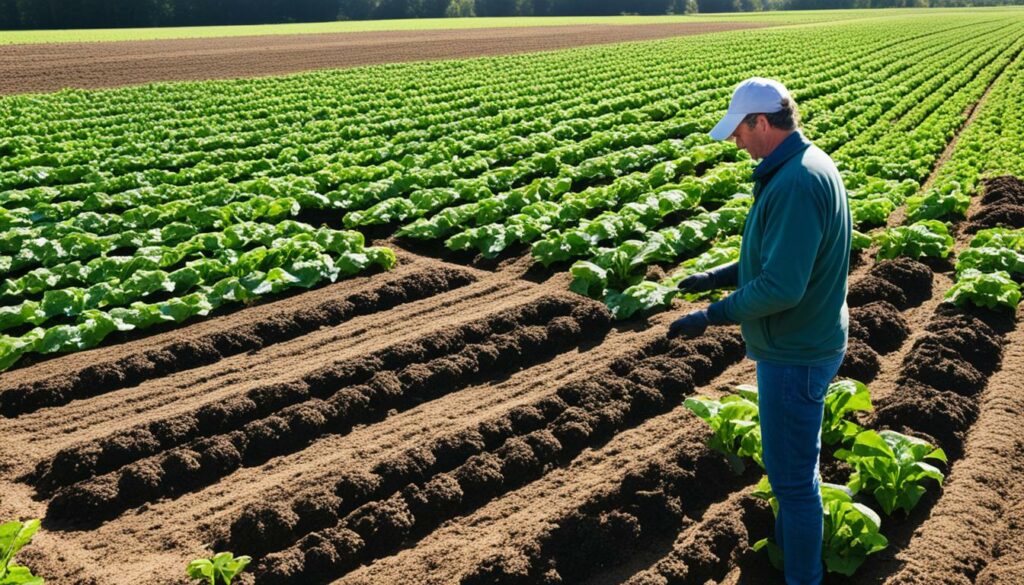
It makes the soil better and delivers more crops. This change also invites a greater variety of plant and animal life. By using the right mix of plants, the farming area stays disease and pest free.
There are other smart farming methods at work, including not ploughing the land often. This and adding stuff to the soil keep it working well over time. These ways make the farm strong and less risky. Plus, they do a lot for the planet by storing more carbon, making less pollution, and improving the land and water.
| Practice | Key Benefit | Impact |
|---|---|---|
| Conservation Crop Rotation | Carbon Sequestration | Boosts soil material and cuts down on CO2 in the air. |
| No-Till Practices | Soil Preservation | Less soil washing away, keeps the ground in good shape. |
| Cover Crops | Weed Suppression | Needs for chemicals are fewer, and water use by plants is better. |
No-till tillage management is a new way to farm sustainably. It means disturbing the soil less and keeping old crops on the ground. This method helps save carbon in the soil and brings big gains for nature and money.
No-till farming holds more carbon in the soil. Keeping soil locked can stop 5.8 million tons of CO2 every year. This is great for fighting agricultural carbon pollution.
No-till farming also cuts emissions from farms. Ploughing the soil is a big source of CO2, making 10% of the U.S.’s pollution in 2019. Changing to no-till can reduce fuel use by 80%, saving 588 million gallons of diesel each year. This not only helps the planet but also makes farms work better.
“Farmers in the United States who use no-till methods save 588 million gallons of diesel fuel annually, and the approach reduces labour-related costs by 30 to 50 percent compared to conventional systems.”
Currently, only a small part of the U.S. farms using no-till methods. More farms could do this and benefit greatly. For example, Macauley Farms in New York earned $25,000 more each year by using no-till. They cut down soil loss by 99% and saved $72 per acre in work and machine costs.
In summary, no-till farming is key in storing carbon and cutting pollution. It saves fuel, reduces work needs, and boosts soil life. This makes it a smart and good way to farm today.
Contour buffer strips are key for controlling erosion in agriculture on sloping land. They are strips of plants set up along the land’s curves. This slows down water running off the land. It lets the soil particles in the water drop and stops them from being washed away.
They keep the soil in place, helping the land stay healthy. They also help water soak into the ground better. This makes the water quality better overall.

Contour buffer strips also do a lot for the environment. They’re great at keeping carbon dioxide out of the air. How? The plants in the strips take in this gas and turn it into soil, making the earth better.
So, they help fight climate change and make the soil more fertile. This benefits farming in the long run.
These strips also create homes for many plants and animals. Lots of good bugs, like bees, can live there. This helps farming be ready for changes in the climate. Farms with these strips are healthier and better for the world’s future.
| Benefits of Contour Buffer Strips | Details |
|---|---|
| Erosion Control | Reduces soil erosion and runoff |
| Carbon Sequestration | Enhances soil carbon stocks through perennial biomass |
| Biodiversity | Provides habitat for wildlife and pollinators |
| Water Quality | Improves water infiltration and reduces sedimentation |
By using contour buffer strips, farmers show they care about the planet and their fields. These strips help keep the soil in place and make the farm more sustainable. They play a big role in farming’s future.
Soil carbon amendments are key for increasing soil carbon stocks and fighting climate change. They use various materials and methods to boost organic matter in the soil. This improves soil health and helps store more carbon.
In farming, soil carbon amendment uses biochar, compost, and pulverised rock. Biochar is carbon from organic sources, staying in the soil for thousands of years. Compost comes from organic waste, adding nutrients and improving soil structure. Pulverised rock, like silicate minerals, helps balance soil pH and gives micronutrients.
| Material | Benefits | Longevity |
|---|---|---|
| Biochar | Enhances soil structure, retains water, and reduces leaching. | Millennia |
| Compost | Provides nutrients, improves soil health and aids plant growth. | Months to years |
| Pulverised Rock | Supplies micronutrients, contributes to pH balance and enhances biological activity. | Years to decades |
Adding soil carbon amendment greatly increases soil carbon. It’s estimated to capture about one GT C per year, equal to 10% of world fossil fuel emissions. This also benefits farm health, boosting crop yields and water storage while making farms more climate-resilient.
Global soils have more carbon than the air—with 2,400 GT C versus the air’s 830 GT C. Upgrading soil carbon holds big promises for fighting climate change. It’s one of the steps to help achieve carbon neutrality in California by 2045. Promoting soil amendments is crucial for both fighting climate change and supporting farming that lasts.
Cover crops bring many good things to the soil, mainly by adding organic matter in soil. They include grasses, legumes, and forbs. These plants can really make the soil better and more fertile.
From 2005 to 2018, studies in the Midwest showed how cover crops help when there’s bad weather. This can mean less money lost because of droughts or heavy rains. By using cover crops, farms can be more stable and continue to do well.
In places where more farmers use cover crops, there are less big losses from bad weather. Cover crops are especially good at protecting farms from too much rain, which can cause floods.
Using cover crops also stops soil from washing away, keeps harmful nutrients out of water, and makes the soil less hard. But that’s not all. They can help your crops grow more, save you money on machines, stop weeds, and even help with bugs. They also make bees happy, get rid of extra nutrients, and are good food for animals. It’s really a win-win situation.
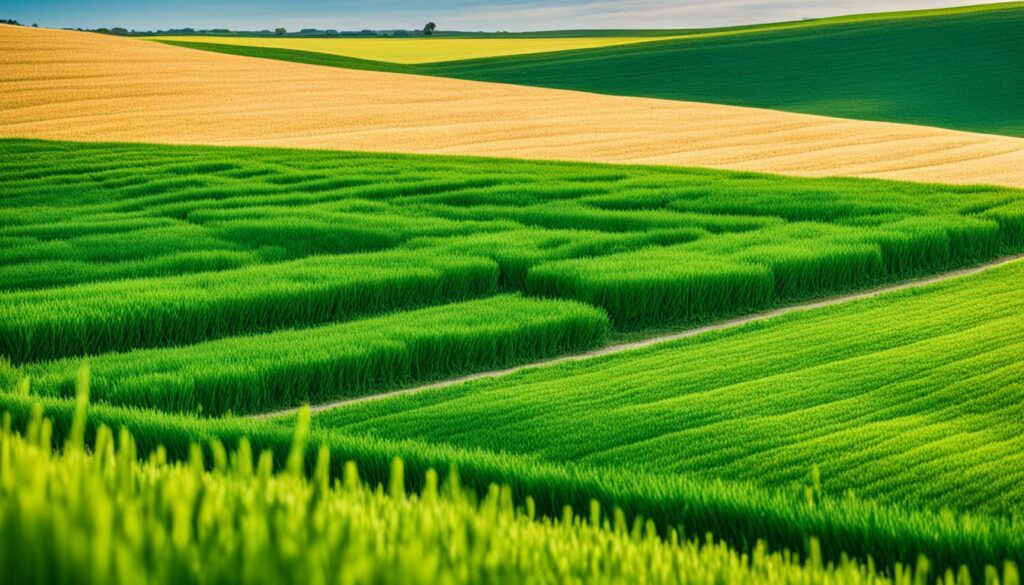
“Planting cover crops can aid farmers in adapting to changing climate trends, such as the increasingly frequent heavy rains in the Northeastern United States and the wetter weather in the spring and autumn reducing the days fields can be worked.”
Cover crops also make water cleaner and control pests by making the soil better at soaking up water. They stop too many nutrients from going into rivers and lakes. The good stuff they do for the soil and your harvests is more than the cost of starting them up.
It’s true that cover crops can use up some of the nitrogen and water that other plants need. But, if you use them right, the benefits are much bigger than any downside. They are key for farming that’s ready for whatever the climate brings.
Field borders are strips of plants at the edges of cropland. They boost biodiversity in farming. These borders help by improving soil health and keeping carbon in the ground.
Adding field borders improves the water we use. These plant strips work like natural filters, cleaning water that flows through them. This helps keep our waterways cleaner and provides better homes for wildlife and pollinators.
Also, the plants in field borders create homes for many creatures. This mix of life is key for keeping the environment in harmony. It helps agriculture be more resilient and better for the climate, aiding in sustainable farming.
Filter strips play a crucial role in smart farming, especially by reducing pollutants in water. They are areas with plants that catch runoff, stopping sediments and pollutants. This slowing down gives time for the ground to absorb water, which helps clean it before flowing into rivers and lakes.
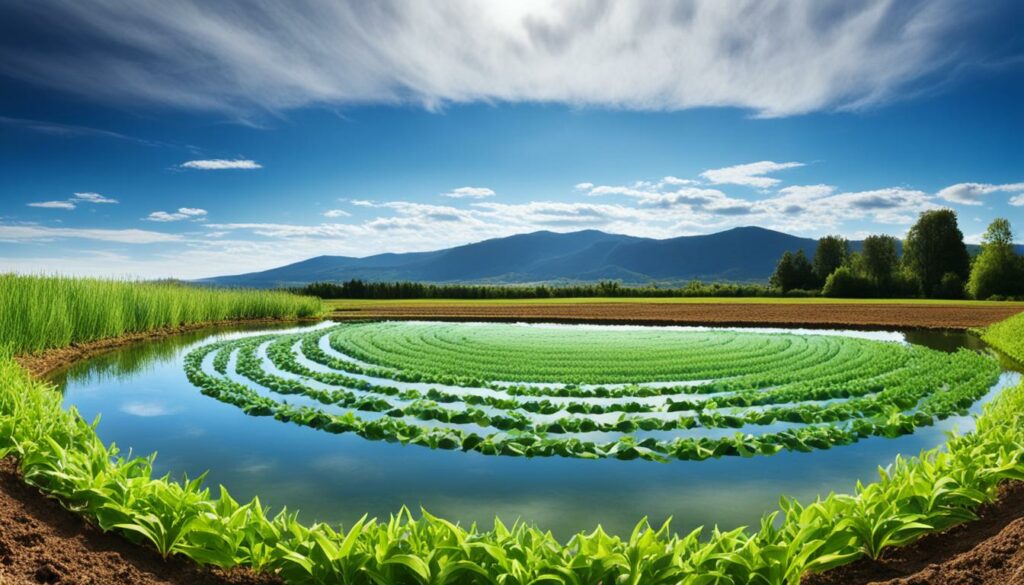
These strips can cut 90% of sediment from farm runoff. They work by slowing the water’s movement and keeping it below 2 feet per second. This helps the ground trap the dirt and pollutants, cleaning the water. It’s also important to check them often, clear out any build-up, and keep the plants healthy for them to work well.
Filter strips aren’t just for water, they also help the plants and ground. They hold water, which seeps into the soil, making it moist and good for plants. By looking after these strips, we can also make the soil and plants healthier. This means better plants and more crops. Though not the best at taking out nutrients, they work well with other methods to make farming more sustainable.
When we make filter strips, we think about the land’s slope and use a special formula to set them up right. They should be wide, at least 8 feet, and their length depends on how much water they get. An important thing is to let the water stay in it for at least 5 minutes to clean it well.
In the end, filter strips are a good and cheap way to deal with water pollution and make farming better. Putting them in the right place and looking after them helps. They are key to keeping our farms and nature healthy for the long run.
Taking up climate-smart agriculture is key in facing our food system’s big problems. The food and farming system globally causes about a third of all emissions. This hugely impacts the climate.By 2050, the world will need more food to feed nearly 10 billion people. This makes it very crucial to use climate-smart farming everywhere. Climate-smart agriculture does more than just cut down on harmful emissions. It also helps lower the use of fresh water and limits the loss of biodiversity.
Farming is a top reason for cutting down forests and producing lots of greenhouse gases. Sadly, the funds to fight climate change in farming are very low, only 4%. And just a fifth of that goes to small farmers.However, the World Bank is stepping up. It’s now giving almost $3 billion every year for smart farming. These efforts aim to meet the goals of the Paris Agreement and make the food system more resilient.
The World Bank is actively working across many countries on its Climate-Smart Agriculture Investment Plans (CSAIPs). It’s supporting projects such as China’s Green Agricultural Program with a $345 million loan. And in Africa, it’s funding programmes like the Food Systems Resilience Program with $621 million.In these areas and more, initiatives are supporting better and stronger farming worldwide.
Pushing for the use of smart farming globally is vital to cut down harmful effects on the environment. Practices like not tilling the soil, planting trees along with crops, and using water precisely are key.Such methods not just improve the land and water but also help plants and wildlife. They lower harmful emissions while protecting nature.
Championing smart farming practices worldwide helps fight the damaging effects of climate change on farming. It ensures food for the future and makes farming stronger everywhere.
Effective climate-smart agriculture relies on strong partnerships across different sectors and enough money from various sources. Governments, banks, and global groups are key in finding and using funds for this effort. They work together to tackle big problems like hunger and bad nutrition.
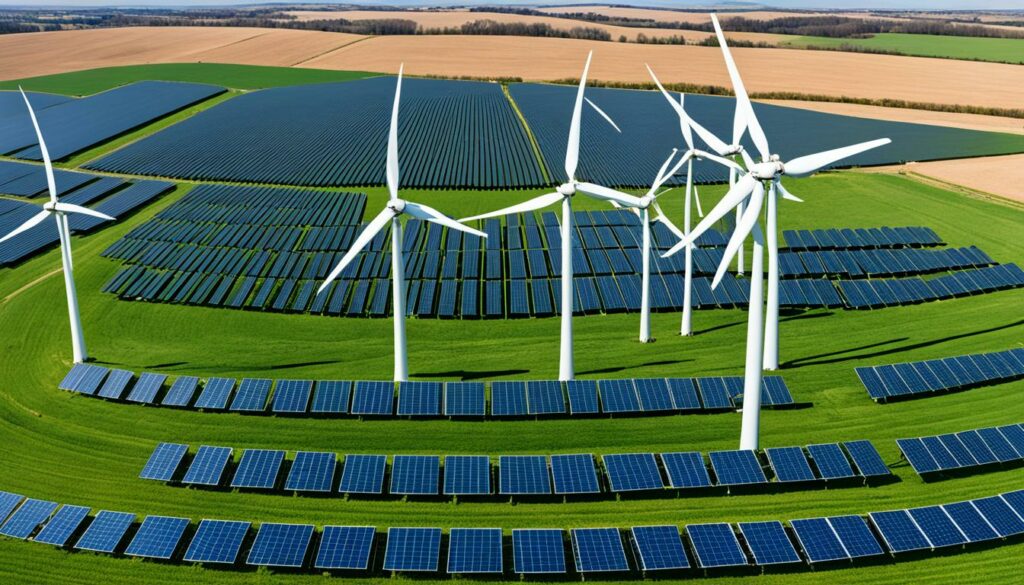
Between 702 and 828 million people faced hunger in 2021; by 2030, 670 million might still be hungry. Malnutrition is behind 45% of deaths among kids, causing extensive stunting in 150 million children around the world. Foodborne illnesses in the U.S. lead to 128,000 being hospitalised, 3,000 deaths, and cost $77 billion yearly.
Government bodies and banks are crucial in providing money for sustainable farming. The USDA’s Initiative, for instance, uses $70 million in grants, with an additional $66 million matched, and $40 million supported by industry. It targets 10.6 million acres and aims for 2.79 million metric tons in greenhouse gas cuts. It also gives $81 million to producers, showing its major impact.
The Regenerative Agriculture Fund offers lower interest rates for eco-friendly farming. Also, the Climate Smart Practice Incentive gives out monetary rewards up to $25 per acre for using conservation methods.
The World Bank plays a big part in pushing for climate-smart agriculture worldwide. It invests in projects that boost farm productivity, make agriculture tougher against climate change, and lower greenhouse gases. Key partners like the Environmental Defense Fund and the Farm Credit Council provide loans, help with tech, and push for better policies.
Big projects like the Farmers for Soil Health and the Midwest Climate-Smart Program, with possible funding around $95 million, show how everyone’s working together. They fit with global climate aims and Sustainable Development Goals to make farming stronger and better for the planet.
As we close our talk on climate-smart agriculture (CSA), remember its big role in farming’s future. Climate changes may harm farming, making it hard to feed everyone. This is especially a big worry in places like Africa and South Asia, where keeping food safe from climate shifts is urgent.
Farming does add a lot to the planet’s greenhouse gases. But, it can also help fix the problem through advanced CSA methods. These techniques cut down on climate harm and make sure we still have enough food to eat. The United States alone could make a huge difference by using these methods. Just by improving the soil, we could grab half of what its farms put out in harmful gases. This shows how powerful CSA can be.
So, it’s really important to keep getting better at CSA. Encouraging farmers to use eco-friendly ways is key, especially in poorer countries where the risk of not having enough food due to climate is high. And if we make farming policies better worldwide, it will help fight off the worst of the changing climate. Now, as the U.S. is deciding on its 2018 Farm Bill, choosing eco-friendly farming is more important than ever. Even though it might cost a bit more, more people are willing to buy organic food. This choice shows that people are starting to care more about the planet.
In the end, everyone – from governments to farmers – needs to work together. It’s all about making our way of farming better for the future. We all share in the job of making sure our farms can keep going, and that there’s enough food for those to come after us.
Climate-Smart Agriculture (CSA) aims to boost farm productivity and make them tough against climate changes. It also tries to cut down on farm emissions. CSA uses both old and new farming ways, like saving soil by not ploughing and managing nutrients well.
CSA’s main goals are to deal with climate change and its threats. By using CSA, farms can lower their emissions and catch more carbon. This process can help them grow better, use water smarter, and handle climate changes well. It helps the economy, the environment, and the people.
Keeping soil as it is helps the structure and the hidden life in it. This keeps carbon in the ground and makes the soil strong against things like erosion. It means using less chemicals and less energy, which is better for the planet.
Hiding the soil with plants makes a healthy place for life. This is good for the soil, the water, and against floods. It also stops the ground from drying out too fast when the weather is hot. Farmers can also use fewer chemicals. So, it’s like a win for everyone and for our planet in the long term.
For protection and to make the soil better, farmers often use plants like grasses and legumes. These plants add a lot of good things to the soil. They also stop it from running off when it rains. This helps to keep the soil full of nutrients.
Using cover crops is a great way to make the soil rich and alive. It helps to keep carbon in the ground and the water clean. It’s also a nice home for many wild animals.
Rotating crops means changing what you plant each season. It’s like a healthy diet for the soil. This helps the ground stay healthy and stop bad bugs from eating too much. It’s also good for the water and air. Over time, the soil can trap more carbon this way.
Farming without ploughing keeps more carbon in the soil. It also helps plants to grow better and need less water. The soil acts like a sponge, holding its own water. So, by doing less, farmers get more and do right by the planet too.
Ploughing less means using less fuel and making less pollution. It’s like choosing to walk instead of taking a car. The air stays cleaner this way, and the planet is happier for it.
Strips of strong plants on hills keep the soil safe. They stop the land from washing away. These plants like trees also help clean the air by storing up carbon. It’s a smart way to protect the farm and the earth around it.
Adding things like biochar and compost makes the soil more alive. It’s like feeding the earth good food. The soil keeps more water this way, and plants grow better. It’s good for the air too.
These changes make the soil a strong safe for hiding carbon. They help the soil to not break up in the rain. It’s also a home for tiny creatures that make the soil even better. So, it’s a part of keeping the earth’s balance.
Using plants all year round makes the soil richer and stronger. It’s like putting a blanket on the earth. Life in the soil makes food for the plants. It’s good for the water and stops the wind from blowing the soil away.
Leaving spots with wild plants is great for many animals and insects. These areas become homes for them. It also helps the water and stops bad things from getting in it. So, the farm becomes a place full of life and good things for everyone.
Filter strips act like a cleaning cloth for the water. They stop dirt and bad chemicals from going in the streams. The plants in these strips help the earth too. They swap bad air for good and make the soil drink more water, keeping it clean.
People all over the world are trying ways to make farming smarter for the planet. They look at what works in their area and use it. The idea is to keep feeding everyone, help the earth, and keep the climate from getting worse.
Big groups like governments and banks are helping farmers to use smart farming. They give money and make rules that are good for the earth. These efforts are part of big plans to fight climate change and make sure we can still grow food in the future.
Groups like the World Bank are cheering for smarter farming with their money and advice. They want farming to be strong and clean, and to help the earth and the people. This is how farming can keep making food and not hurt the planet too much.